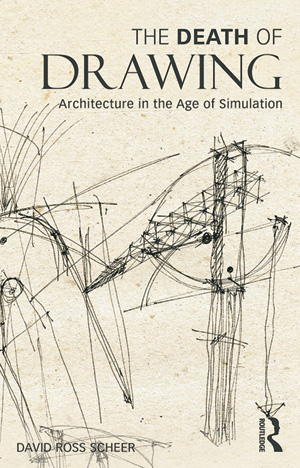In The Death of Drawing, David Ross Scheer, an architect and teacher specializing in digital technologies, lays out the contemporary practices of design that have pushed aside architectural drawing as the dominant means of architectural expression. The author crafts his sentences precisely, illustrating ideas that explain concepts clearly. If one wants to know what is going on in the profession and schools of architecture, this book is a must read.

As a professor of architecture who teaches drawing, I was fascinated by this contemporary analysis of the act of creating. Scheer argues that architecture for the past 500 years has followed Alberti's paradigm of drawing's being distinct from building. The architect's domain lies in theory, and the why of architecture is more important than the how. As a result, the craft of drawing has served as the link between idea and the physical aspects of building.
Drawing connects architectural ideas to the representation of mental images by which we perceive reality. Scheer provides an engaging discussion of these points, but emphasizes the ambiguity involved in representation. He argues that drawings increasingly need to function as instruments of construction, because computational technology eliminates ambiguity and “collapses the distance” between reality and representation. Building information is packed into data, and simulations quickly and accurately manage information.
Scheer further argues that the creation of form now follows geometries native to the computer and therefore is no longer a product of the act of representation. In the profession, BIM has made the design process transparent and accessible to architects and builders alike, challenging architects' role as leaders. Design team members manage the production of information, putting an emphasis on collaboration. A new dynamic is at work.
So why continue to teach drawing? One reason is that the almost seamless relationship between eye, brain, and hand helps establish the body as “the center of experience,” says Scheer.
While Scheer admits his love of drawing was an important reason he studied architecture, he proclaims that the future is brighter for young architects who can design within the new paradigm of digital technology. Citing Frank Gehry's 8 Spruce Street tower in New York, he notes that Gehry's firm parametrically adjusted the facade so it embodied the design idea, rather than let it result simply as an outcome of a computational process.
Scheer says we need to understand the myriad tools available to us, but be smart enough to lead with design rather than performance. Architects need to talk back to BIM and preside over the course of design. We need to ask the hard questions: What is design today? Is it more than performance and information? Drawing remains the key to synthesizing the vision of an architectural idea concisely.
Sophia A. Gruzdys is an architect and director of Catholic University's Rome program, and also teaches design at the University of Southern California's Barcelona program.

Post a comment to this article
Report Abusive Comment